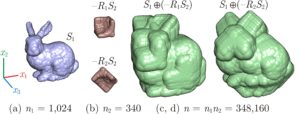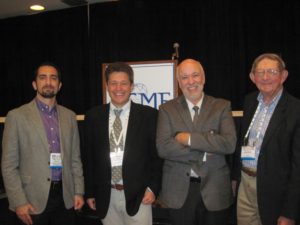When Robert Valley Sr. entered the doors of Castleman in 1946, he did not know that he was starting a legacy. Now – almost 70 years later – three members of the family have walked through those doors and graduated in 1950, 1978 and 1981. And another generation is expected to graduate in May of 2016.
This is one of the Legacy Families that the School of Engineering is trying to find and chronicle – families that return to UConn’s School of Engineering and consider it home. (Contact information below.)

From left to right: Robert Valley Sr., Stephen Mierz, and Matt Mierz
For Robert Sr., engineering seemed natural. He had always wanted to be an engineer. “Early on, I got into ham radios,” he said. “It was fascinating to have a piece of block and a coil and some headphones and tune into your local radio station.” Those days of tinkering were a great time for people with an engineering bent. But today’s devices are too complex, said the Branford resident. “You can’t even take them apart and understand what’s inside. The circuitry is not accessible.”
His son, Robert Valley Jr., chief engineer with Branford-based Analytica, recently acquired by PerkinElmer, felt the same affinity for Engineering. “It just seemed to be the appropriate path,” said the man who started his own business at age 15. Bob Jr. created “Rapid Robert’s Repair Services,” during a summer vacation to fix tape recorders for SoundScriber Corp., then his father’s company. From there, the path was natural. Bob Jr. graduated from UConn with a degree in Electrical Engineering in 1978 without even discussing it with his father, the men said.
The legacy does not stop there. Robert Sr.’s daughter Diane met her future husband Stephen Mierz here at UConn. He graduated in 1981 with a Mechanical Engineering and Materials Engineering degree. Steve caught the engineering bug from his father, who did engineering work, but did not have a degree. His father encouraged Steve to pursue his degree so that he would have more career options.
Taking his father’s advice, he attended Engineering career fairs and met with Sikorsky, where he has worked ever since. He now handles forensic engineering, inspecting brakes, wheels and other parts that have failed, and figures out how each failure occurred. “At the end of the day, to be contributing to something that makes the company more successful, that’s a good feeling,” he said. “Money’s good, but I think you need to have job satisfaction that makes every day interesting and fun.”
Steve’s worn a lot of different hats at Sikorsky, and advises his son and other UConn Engineering students to be adventurous and flexible. “Be open to things at whatever company you go to,” he said. “Don’t decide that you’re going to do just one thing. Be open to possibilities. There is a lot of neat stuff that you can do, especially if you go to a big company.”
His son, Matt Mierz, who’s carrying on the family legacy at UConn, is scheduled to graduate next year with a degree in Mechanical Engineering. Matt said he and the elder engineers in his family will occasionally talk about how the field has changed, and how much the UConn Engineering School has expanded. His interest in engineering includes cars and motorcycles. “I went into it because I enjoyed it.”
The UConn School of Engineering is proud of the families making engineering a part of their family tradition. Alumni and students who are the children, grandchildren, parents, grandparents or siblings of School of Engineering graduates are legacies. Please keep in touch with your School and confirm your legacy status with the Director of Engineering Alumni Relations, Heidi Douglas (hdouglas@engineer.uconn.edu). We hope to hear from you.



 team began the four day Formula SAE Competition at Michigan International Speedway in Brooklyn, Michigan. The Formula SAE® Series competitions challenge teams of university undergraduate and graduate students to conceive, design, fabricate and compete with a small, formula style, competition vehicle. To give teams the maximum design flexibility and the freedom to express their creativity and imagination there are very few restrictions on the overall vehicle design. Teams typically spend eight to twelve months designing, building, testing and preparing their vehicles before a competition. The international competitions themselves give teams the chance to demonstrate and prove both their creation and their engineering skills in comparison to teams from other universities around the world. The University of Connecticut has fielded a vehicle in the largest of these competitions, Formula SAE Michigan,
team began the four day Formula SAE Competition at Michigan International Speedway in Brooklyn, Michigan. The Formula SAE® Series competitions challenge teams of university undergraduate and graduate students to conceive, design, fabricate and compete with a small, formula style, competition vehicle. To give teams the maximum design flexibility and the freedom to express their creativity and imagination there are very few restrictions on the overall vehicle design. Teams typically spend eight to twelve months designing, building, testing and preparing their vehicles before a competition. The international competitions themselves give teams the chance to demonstrate and prove both their creation and their engineering skills in comparison to teams from other universities around the world. The University of Connecticut has fielded a vehicle in the largest of these competitions, Formula SAE Michigan,  located at the Michigan International Speedway since the team began just seven years ago. With over 120 colleges and universities registered, Formula SAE Michigan is the largest of its kind. Over the course of four days, the cars are judged in a series of static and dynamic events including: technical inspection, cost, presentation, and engineering design, solo performance trials, and high performance track endurance. These events are scored to determine how well the car performs. Come close of competition the team executed an incredible performance placing 20th overall
located at the Michigan International Speedway since the team began just seven years ago. With over 120 colleges and universities registered, Formula SAE Michigan is the largest of its kind. Over the course of four days, the cars are judged in a series of static and dynamic events including: technical inspection, cost, presentation, and engineering design, solo performance trials, and high performance track endurance. These events are scored to determine how well the car performs. Come close of competition the team executed an incredible performance placing 20th overall out of the 120 teams in attendance at one of the most competitive events of the year. This milestone places UConn Formula SAE amongst the elite, solidifying that they are a force to be reckoned with. In the midst of teams with decades of experience, a sizable team base, and much larger budgets, UConn Formula SAE is still considered in its youth as building a successful vehicle involves extensive growth in both engineering and team dynamics. With the continuing support of sponsors and the department of mechanical engineering, UConn Formula SAE is working towards even greater success with the refined design and manufacture of the 2014-2015 vehicle already underway.
out of the 120 teams in attendance at one of the most competitive events of the year. This milestone places UConn Formula SAE amongst the elite, solidifying that they are a force to be reckoned with. In the midst of teams with decades of experience, a sizable team base, and much larger budgets, UConn Formula SAE is still considered in its youth as building a successful vehicle involves extensive growth in both engineering and team dynamics. With the continuing support of sponsors and the department of mechanical engineering, UConn Formula SAE is working towards even greater success with the refined design and manufacture of the 2014-2015 vehicle already underway.